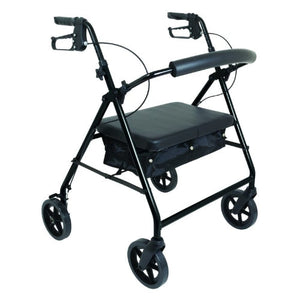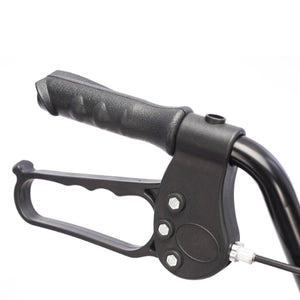Mobility aids are essential tools for individuals who need assistance with movement due to age, disability, injury, or other health conditions. These devices play a critical role in improving the quality of life by providing support, stability, and independence. Whether it’s a walking cane, a wheelchair, or a transfer board, the right mobility aid can make everyday tasks easier and safer. In this blog, we will explore various types of mobility aids, their benefits, and frequently asked questions (FAQs) to help you choose the best option for your needs.
Types of Mobility Aids:
-
Walking Canes and Sticks
One of the standout features of the Shoprider Flagship Cabin Scooter is its fully enclosed cabin design, which shields users from the elements. Whether it’s rain, wind, or extreme sunlight, this scooter provides a comfortable environment that allows for year-round use. This makes it an ideal choice for individuals living in regions with unpredictable weather or those who enjoy outdoor activities regardless of the season. -
Walkers and Rollators
Walkers are designed for those who need more assistance than a cane can provide. Traditional walkers offer a solid frame with four legs, while rollators come with wheels, hand brakes, and a built-in seat for added convenience. These aids are suitable for individuals who need continuous support while walking. -
Wheelchairs
Wheelchairs offer mobility to those who are unable to walk or have limited walking ability. Manual wheelchairs require the user or an attendant to push them, while electric wheelchairs operate with a motor and are controlled using a joystick. Wheelchairs enable users to move around independently, both indoors and outdoors. -
Mobility Scooters
Mobility scooters are an excellent option for individuals who can’t walk long distances but still want to maintain their independence. These battery-powered scooters are easy to operate, providing a comfortable and convenient way to travel over short and medium distances. -
Transfer Boards and Lift Chairs
Transfer boards and lift chairs assist individuals in moving from one place to another, such as from a wheelchair to a bed or car. These aids reduce the physical effort required for transfers, making them safer and more manageable for both users and caregivers. -
Grab Bars and Shower Chairs
Grab bars and shower chairs are essential aids for those who need extra support in the bathroom. Grab bars provide a secure handhold for balance, while shower chairs allow users to sit safely while bathing, reducing the risk of slips and falls.
Benefits of Using Mobility Aids:
- Increased Independence: One of the main benefits of mobility aids is that they empower individuals to move around independently. This increased sense of freedom can significantly enhance self-confidence and improve overall well-being.
- Improved Safety: Mobility aids reduce the risk of falls and accidents by providing stable support. Whether using a cane, walker, or grab bar, these devices help users maintain balance and stability.
- Enhanced Comfort: Many mobility aids are designed with user comfort in mind. Devices like rollators come with padded seats, while wheelchairs often feature ergonomic designs that ensure prolonged comfort during use.
- Support for Caregivers: Mobility aids also make the job of caregivers easier by providing the necessary tools to assist with transfers, movement, and daily activities. This reduces physical strain and ensures safer handling.
- Accessibility and Convenience: From electric scooters to transfer boards, mobility aids make various environments more accessible. They allow users to navigate different terrains and settings comfortably and conveniently.
Frequently Asked Questions (FAQs):
Q1: How do I choose the right mobility aid for my needs?
A1: Choosing the right mobility aid depends on your specific requirements and level of mobility. Consider factors such as stability, comfort, and ease of use. Consulting a healthcare professional can also help you make an informed decision based on your health condition.
Q2: Are mobility aids covered by insurance?
A2: Many insurance plans cover mobility aids, but the extent of coverage may vary. It’s essential to check with your insurance provider to understand what types of devices are covered and if there are any prerequisites or conditions.
Q3: How do I maintain and care for my mobility aid?
A3: Regular maintenance can extend the life of your mobility aid. For example, clean your walker or wheelchair periodically, check for loose screws or parts, and ensure that the wheels and brakes are functioning correctly. Refer to the manufacturer’s guidelines for specific care instructions.
Q4: Can mobility aids be used outdoors?
A4: Yes, many mobility aids are designed for both indoor and outdoor use. Devices like electric scooters, wheelchairs, and rollators can be used on various terrains, allowing users to navigate parks, sidewalks, and even stores comfortably.
Q5: What is the weight capacity for most mobility aids?
A5: The weight capacity of mobility aids varies depending on the design. Canes and walkers usually support up to 250 pounds, while bariatric models can handle more weight. Wheelchairs and scooters also come with different weight limits, so it’s essential to choose a model that meets your requirements.
Conclusion
Mobility aids are vital for those who need support in their daily activities, offering safety, comfort, and independence. Whether it’s a simple walking cane or a sophisticated electric scooter, these devices help users lead more active and fulfilling lives. By understanding the types and benefits of mobility aids, you can make an informed choice that best suits your needs. If you or a loved one is struggling with mobility, consider exploring the range of aids available to improve daily life and boost confidence. Remember, the right mobility aid can make a significant difference in how you navigate your world, ensuring safety and freedom every step of the way.









